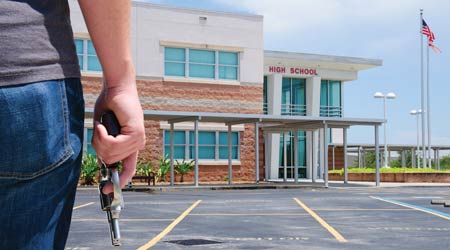Active shooters were nearly unheard of as a threat to facilities at one time, but that time has passed. Now, maintenance and engineering managers, especially those in education facilities, need to prepare for such situations, according to an article from Facilities Maintenance Decisions on the FacilitiesNet website.
One key component of any facility’s security and access control plans against unwanted intruders is door hardware — including locks, handles, hinges and operators — that delivers durability and reliability. By taking security into consideration during specification, installation, inspection and testing, managers can ensure hardware integrates effectively with access control systems and delivers the desired security.
Robust entry door locks and accessories, such as latch guard plate covers, are a key consideration during door lock specification, especially for facilities that depend on delayed entry to protect occupants against active shooters. With large numbers of defenseless occupants concentrated closely together, a shooter is close to occupants after achieving entry. This situation makes first responders’ challenge more difficult because of the potential for innocents being in the line of fire or used as hostages.
To ensure door hardware delivers effective security, managers need understand the product manufacturing process and ensure installers follow recommended procedures. They also need to follow up with careful inspection and testing.
Manufacturers of locks, handles, hinges, and operators use ANSI/BHMA A156. Specific door specification standards for steel door manufacturing are contained in ANSI/SDI A250.8. The best specifications for locks and doors might not provide adequate security if the installation is sub-standard. Initial testing and regular follow-up with inspection, testing and adjustment are necessary parts of any security program.

 UF Health Hospitals Rely on Green Globes to Realize Their Full Potential
UF Health Hospitals Rely on Green Globes to Realize Their Full Potential How Healthcare Facilities Can Be Truly Disaster-Resilient
How Healthcare Facilities Can Be Truly Disaster-Resilient TriasMD Breaks Ground on DISC Surgery Center for San Fernando Valley
TriasMD Breaks Ground on DISC Surgery Center for San Fernando Valley Bigfork Valley Hospital Falls Victim to Data Breach
Bigfork Valley Hospital Falls Victim to Data Breach AI-Driven Facilities: Strategic Planning and Cost Management
AI-Driven Facilities: Strategic Planning and Cost Management